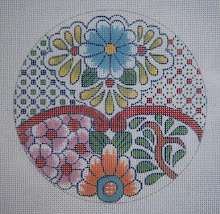 Having noticed a lot of the Mexican ceramics showing calla lilies lately - especially the Talavera style, I decided to investigate, as this is not a motif used on the traditional Spanish Uriarte, which has been produced in Puebla, since the 16th century.
Having noticed a lot of the Mexican ceramics showing calla lilies lately - especially the Talavera style, I decided to investigate, as this is not a motif used on the traditional Spanish Uriarte, which has been produced in Puebla, since the 16th century. I had always associated this flower with condolences on greeting cards designed to send to the bereaved, and therefore a bit depressing - but when I moved to Mexico City in the 60's, I was surprised to find that it's a most beloved flower, and used primarily at Easter.
This makes sense, as it's a symbol of re-birth and resurrection. The white version of it is also used at weddings, as it's a symbol of marriage and purity. Here, we use a true lily for this time of year, and call it the "Easter lily." Not a true lily, the Calla lily is indigenous to Africa (I don't remember which part) but traveled to Mexico at some point.
Digging a little further, I discovered some things I didn't know. The Aztecs were a "flowery" civilization, having many of their religious and spiritual activities centered around the use of many many of them. A vast number of their deities also had flowers as their symbols.
Archaeological discoveries have shown the Mayan civilization to have also been a flower culture. The valley of Mexico is, indeed, a most beautiful place with a vast wealth of gorgeous flowering plant life.

I've also always loved the paintings by Diego Rivera in which he used many many calla lilies, painted very simply, flat, and always in white (at least I've never seen anything but white in his work.) I think this is what prompted me to do a little bit of research as to why it's so prominent also in the modern version of Mexican tiles and other ceramic items.
I had held back from adapting these ceramics to needlepoint, as I still had that bit of stigma in my mind about the Calla lily being used at funerals, but now I've done two pieces, and understand the "why" of it, so will continue to do a few more! This one is now on my ebay auction, which is kind of my testing ground to see what others think.

No comments:
Post a Comment